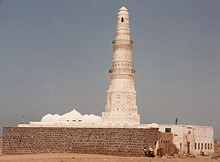Mocha (city)
|
المخا mocha |
||
|---|---|---|
|
|
||
| Coordinates | 13 ° 19 ′ N , 43 ° 15 ′ E | |
| Basic data | ||
| Country | Yemen | |
| Ta'izz | ||
| ISO 3166-2 | YE-TA | |
| height | 13 m | |
| Residents | 10,146 (2012) | |
Mocha (fromالمخا al-Muchā , DMG al-Muḫā , also Mukha , Mokha , English Mocha ) is a formerly flourishing Yemeni port city on the Red Sea . It is located at an altitude of 12 meters above sea level and has about 10,000 inhabitants.
Mocha , a special type of coffee preparation, is named after the former export port for Yemeni coffee .
history

The coffee plant probably comes from the opposite Ethiopia and has its home in the Yemeni highlands. From the cultivation regions at an altitude of 1000 to 2000 meters, the beans were brought to the port of export by camels. Became known Mocha in Europe since the 16th century. In 1554 a coffee house was opened in Constantinople (Istanbul) . Coffee beans from Alexandria came to Venice for the first time in 1615 , where the first coffee house was opened in 1645. He was followed by others: 1650 in Oxford, 1652 in London , 1659 in Marseille, 1663 in Amsterdam and The Hague, 1672 in Paris, 1673 in Bremen, 1677 in Hamburg, 1685 in Vienna, 1686 in Regensburg and 1694 in Leipzig.
The cityscape was characterized by multi-storey, white plastered houses of wealthy Arab traders and resembled other port cities on the Red Sea with which Mocha exchanged goods and competed in trade with India : Hodeida , al-Luhayya , Jeddah and on the African side Massaua (in today's Eritrea ), Suakin and Aidhab (both in Sudan). At the beginning of the 17th century, the Dutch and British founded trading establishments, and in the 18th century the French too. The goods were handled locally, and the foreign traders were not allowed to penetrate the isolated highlands. Up to 30,000 people lived in the city in the 17th and 18th centuries. This was the heyday of al-Mucha , which had the monopoly in the world trade in coffee and could hardly keep up with deliveries to Europe.
In search of bases, Mocha was occupied by British marines in 1820, but in 1839 a decision was made in favor of a British trading colony in Aden . The decline began with the expansion of the port in Aden in the mid-19th century and was accelerated by the chaos of war. Coffee was marketed around the world during colonial times.
It is believed that the ancient port city of Muza was at the site of today's Mokka.
Todays situation
The large residential and trading houses from better times are gradually being leveled by the sand dunes of the Tihama Desert and are practically no longer inhabited. In front of and next to these (structural) ruins, the inhabitants mostly live as fishermen in simple accommodations. In the 1994 census, the population was 10,355, including a large settlement on the access road in the east. For 2005, 14,562 inhabitants were estimated. The calculation for 2012 is 10,146 inhabitants. An industrial port was built two kilometers south of the village. There is little border traffic with boats to Djibouti and Berbera .
The remains of the old lighthouse are worth seeing, as are the remains of wall decor on the old merchants' houses and the white minaret of the Great Mosque from the 15th century.
See also
literature
- Hans Becker, Volker Höhfeld, Horst Kopp: Coffee from Arabia. the change in the meaning of a global economic good and its settlement-geographical consequence at the dry border of ecumenism , Wiesbaden (= geographic knowledge 46), 1979
- CG Brouwer: Al-Mukha. Profile of a Yemeni Seaport as Sketched by Servants of the Dutch East India Company (VOC) 1614-1640. D'Fluyte Rarob, Amsterdam 1997. ISBN 90-800267-6-X . Book review Daniel Martin Varisco in: Yemen Reviews
- Eric Macro: The Topography of Mocha. In: Proceedings of the Seminar for Arabian Studies, Vol. 10. (Proceedings of the Thirteenth Seminar for Arabian Studies held at the Middle East Center, Cambridge on 25th - 27th July 1980) 1980, pp. 55-66
- Nabil Osman: Small lexicon of German words of Arabic origin . Beck, Munich 2002, p. 91, ISBN 3-406-475841
- Nancy Um: Spatial Negotiations in a Commercial City: The Red Sea Port of Mocha, Yemen, during the First Half of the Eighteenth Century. In: Journal of the Society of Architectural Historians , Vol. 62, No. 2, June 2003, pp. 178-193
Web links
- Dirar Abdel-Daim: Mokha. The City of the Past and the Future. ArchNet
Individual evidence
- ↑ Kaffeefibel.com: Mocha - The city from which coffee came
- ^ City Population.de: Yemen. All places with more than 10,000 inhabitants
- ↑ 2005 population estimates for cities in Yemen.
- ↑ Archived copy ( Memento of the original dated December 29, 2011 in the Internet Archive ) Info: The archive link was automatically inserted and not yet checked. Please check the original and archive link according to the instructions and then remove this notice.

